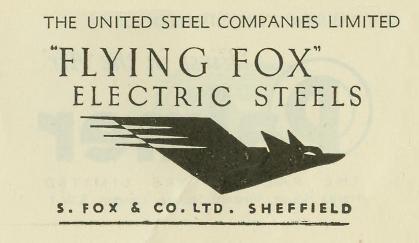This is a small, "back-of-the-book" ad from an aeronautical magazine of 1949. (The faint secondary image in print-through from the other side of the page.)
So?
It's interesting as a tiny window into another time and place. What can we deduce from this?
1. At least for minor "name recognition" ads in postwar England, the basics of typesetting (as we think of them now) weren't considered very important. None of the lines are centered, even in relation to one another. Kerning, to make letters of different sizes appear to be evenly spaced, never crossed the typographer's mind.
2. On the other hand, the Flying Fox logo is delightful: a quasi-geometric, post-Art Deco fantasy. This was a decade before corporations started going in for meaninglessly abstract logos that were the equivalent of Bauhaus architecture, untouched by human hands. The Flying Fox, as befits a steel manufacturer's symbol, is dignified but symbolizes motion (because the company's products were used mainly in aircraft?) and induces that mythological tingle we feel when kinds of animal are combined, as in a centaur or sphinx.
3. These "electric steels" (I'm not up enough on steel technology to tell you what that means) were made in Sheffield, where "The Full Monty" was set in a post-industrial wasteland. But, obviously, in 1949 the city still had a reason for being: they made things there.
4. The company had very likely been founded, probably in the 19th century, by one S. Fox. His descendants had been bought out by a bigger firm, United Steel Companies.
Googling "Flying Fox Electric Steels" or "S. Fox & Co." yields no useful results. I wonder if anyone in Sheffield today remembers them. United Steel Companies is listed on the site of the Durham Mining Museum; apparently it mined its own coal for its steelworks. It was nationalized in 1947 under Britain's Socialist government, although the board doesn't seem to have changed much from that of 1940, and as we have seen, it was still running adverts in shameless capitalist fashion.
As a note on the bizarre socio-political status of Britain at the time, it can be seen that this government-owned corporation was still headed by a baronet -- the bottom rung of the English artistocracy, but still, an aristo. Nor had the proletariat seen off the Right Honourable W.S. Morrison, M.C., K.C., M.P. from his director's chair.
The director lists for 1940 and 1947 show where captains of industry lived. J. Henderson was at home at 44 Campden Hill Gate, London, W.8. I can place that: it's in Kensington, still a tony district, and I've been to a meeting of the Society for Psychical Research in the Campden Hill Library. Residences of other board members offer the flavour of Old England: The Manor House, Tittensor, Stoke-on-Trent; High Rogerscale, Lorton, Cockermouth, Cumberland; 4b Fredericks Place, Old Jewry, London, E.C.2 (I bet "Old Jewry" has since passed out of use); Chetwode Priory, Buckinghamshire.
So it was, in the day of the Flying Fox.


1 comment:
Img,
You're right, of course, about a flying fox being a kind of bat. I'd known that sometime, but had completely forgotten. Zoology is obviously not my patch.
I don't see what you mean about each each line being offset to the right of the line above.
Post a Comment